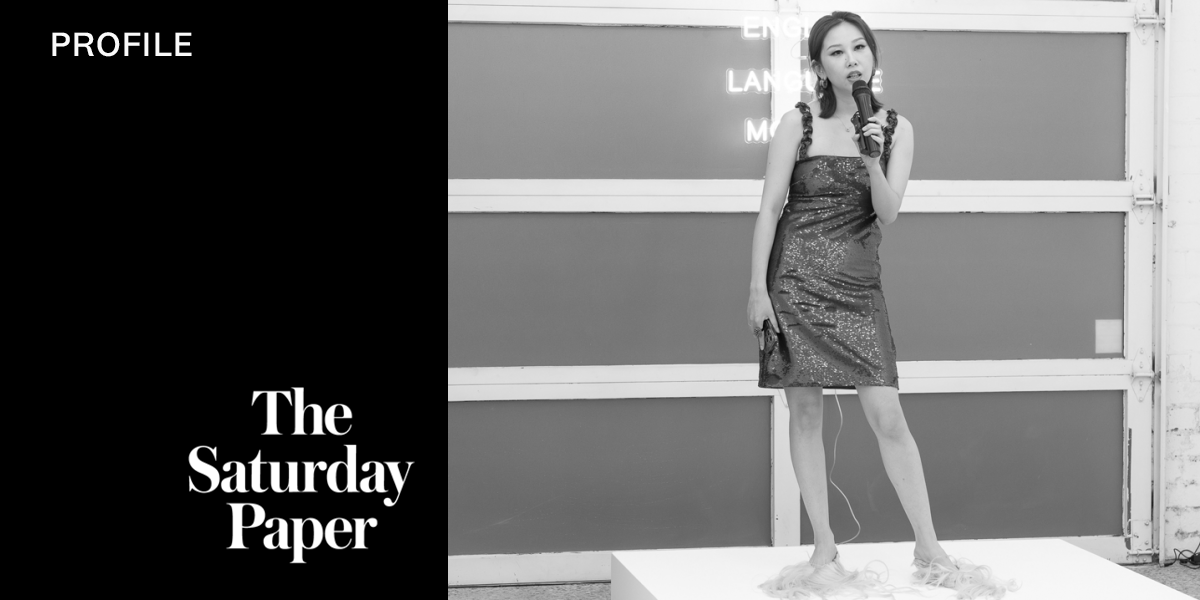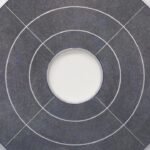
Chunxiao Qu stands in a green sequin dress and Balenciaga stilettos that are sprouting wig-like hair, hip cocked as she dangles a microphone, ready for her first comedy show – or what she calls her “stand-up comedy performance art”. She pauses, then says sardonically, “I know this sounds stupid, because it is.”
Gathered at Gertrude Glasshouse, a petite gallery in Melbourne, is a small but enviable art world crowd – here for the opening of Qu’s latest exhibition, which is showing through May. “No laughing?” demands Qu. We start laughing. She hoots, we hoot back. The performance is dedicated to those “who thought this was a TED talk”. There are jokes about the penises in Qu’s art and how although artists hate capitalism, “they have to manage just like everyone else”. The anticipatory line, “I love my husband”, gets the biggest laugh.
The performance delivers the simultaneously soft and sharp one-liners that define Qu’s practice, which consists of text in neon lights, artworks referencing conceptual artists, and two poetry collections. While the Gertrude show’s central neon text work shares the exhibition’s title, I Am a Contemporary English Language Mother (2025), there are also mirrors that say “I AM YOU AND YOU ARE ME” and “too fun to run”. Nearby are the hairy stilettos and two golden guns pointing at one another, the stand-off titled We Kissed (2025).

For Qu, a Chinese artist who has lived in Melbourne since 2015, the show has a “revenge” mentality. “Revenge has the power to break the rules,” she says. “Like do a stand-up show, call it performance and do it in a gallery. When I say revenge, it’s a questioning: why [does] it have to be this way?” Speaking of the stilettos: “Why use animal feathers to make fashion? Why can’t I use hair too?”
In flouting conventions to underline their strangeness, Qu’s art obsessively holds the tensions between form, language and power. “Like when I say I’m a ‘contemporary English language mother’, it’s because an English mother should be an English speaker. But I’m Chinese. I don’t speak well English, but I say I’m a contemporary English mother because it’s a kind of revenge.”
This seizing of power, of taking the label “English speaking” to unravel its supremacy, is how Qu scrutinises power dynamics. Language is a medium but also an authoritative body that Qu wants to expose: “People may be thinking I’m interested in playing with language, but I think I’m questioning it.”
Qu is in demand. She’s just finished a solo show at 4A Centre for Contemporary Asian Art in Sydney, titled as tragedy / as farce, filled with desperately comic lines for the capitalist present. In pastel neon lights, Qu examines our cultural obsession with emulation via the line “EVERYONE IS EVERYONE ELSE”. Or take this aphorism, fit for Millennials and Generation Z who balance life between personal ambition and planetary extinction: “GO FIND SOMEONE TO FALL IN LOVE WITH BEFORE THE END OF THE WORLD.”
Another of Qu’s neon texts, An artist doesn’t need a label (2022), is currently at Adelaide’s Samstag Museum of Art, in a show about communication. Qu’s work includes lines such as “GOOGLE TRANSLATION IS WRONG AND I AM RIGHT” and “GENIUS DON’T NEED TO WORK HARD”. For Samstag curator Gillian Brown, the lines, featured in both English and Mandarin, elicit the processes of translation and the “power dynamics that are always running below the surface of any exchange of words, particularly when working between languages … Qu strips the ego from the English language”.
I asked Qu about being a genius – especially since the word became unfashionable in the late 20th century, rather than being expanded to anyone other than white men. “I do feel I’m a genius sometimes,” she says. “Sorry.” It’s also an ironic snipe at people who think conceptual artists don’t work because their art is thought-based. “When I am thinking,” explains Qu, “I’m working hard because I’m thinking hard.”
In March this year, Qu showed at Melbourne Art Fair with FUTURES Gallery, exhibiting her iconic piece Boyfriend Table (2024), which is also at Gertrude. Positioned on all fours is a life-size sculpture of Qu’s husband as a coffee table, complete with a fish tank and plant holder. He’s wearing a suit and his penis is a metre-long engorged cactus.
At the fair, as a gallerist explained I could transform my partner into a table for $12,000, I looked over and saw Qu’s husband standing alone, watching his wife talk to potential buyers as she gestured towards him. Qu laughs kindly at this. Her husband knew the table was coming, but the fair was the first time he saw it. “He said that he doesn’t want to be famous in this way, but if that’s the only way, he’ll take it.” And why did she choose her husband? “Because I love him,” she replies. “It’s his honour.”
It’s also a continuation of Qu’s series of “tribute” works, which copies the art of conceptual artists with her own alterations. The coffee table is a reference to Allen Jones, a British artist who contorted female bodies into tables and chairs. “It’s my revenge attitude,” says Qu. “Why can men use a woman’s body to make furniture? Why can’t I use a man’s body?”

Qu’s first substantial tribute exhibition was at 99% gallery in 2022, where during 31 days she made 31 tributes to different artists. For instance, in one tribute to American artist Ed Ruscha, Qu transformed his text work 99% Angel, 1% Devil to her own version: 99% Now, 1% Future. The show’s curator, Chelsea Hopper, met Qu in 2019 at Monash University, when Qu was doing a collaborative installation with artist Alex Hobba. “It was about 30 banana peels all scattered on the floor,” says Hopper. “Think Mario Kart.”
While many tributes at 99% gallery were mock-ups, the show had an international life on Instagram. A tribute to American artist Deborah Kass saw Qu appropriate Kass’s blue and yellow text “OY” and “YO”, symbolising equality and fairness. Qu’s tribute used the same colours and layout but with “GOD” and “DOG”. When Qu posted it on Instagram, Kass commented with the “praise hands” emoji.
In the space between “appropriation and elitism”, one of Qu’s most memorable tributes is her fly embalmed in resin, a tribute to British artist Damien Hirst’s infamous shark in formaldehyde. Qu’s work partly questions Hirst’s ongoing practice of preserving animals in formaldehyde, which makes him millions. “I don’t feel jealous he gets successful and makes the market work,” says Qu. “I just don’t like how he treat his own art career. I’m criticising that.” Hirst might make art, but the art also ends up making the artist.
By copying artists who copy themselves – and vampirically treating conceptual works as ready-mades for her own use – Qu up-ends authorship and worthiness. Many conceptual artists challenge the value of originality while championing that ideas matter more than form. But if Qu copies Hirst’s form and inserts her own animal or ideas – did Qu make the work, or Hirst? Does it matter that Qu copies Hirst when he copies himself anyway? Why is Hirst’s work more valuable than Qu’s? Perhaps, it turns out, that form and originality do matter after all. Qu ultimately questions the concepts of authorship and value that older conceptual artists thought they were questioning.
Yet it’s not all irreverent. Qu genuinely acknowledges her influences – something many artists are at pains not to do – situating herself within conceptual art. When younger artists today are trained in the aesthetic backflips of the 20th century, their output seems less interested in killing idols than recontextualising them.
For her part, Qu keeps her artistic possibilities open by refusing her own style in advance: she’d love to be challenged on her art. As she said in the Cordite Poetry Review: “I wish someone would say to me: ‘You think this is poetry? Fuck you!’ ”
On Instagram, where Qu regularly posts text, she calls herself an “art critic and comedian”. With her art commenting on the art world (I particularly love the work CONTEMPORARY ART IS WHAT GARBAGE IS) she aligns with the famous conceptual artist Joseph Kosuth, who held that one should use art itself to challenge art: “Texts about artworks are experienced differently than texts that are artworks.”
Kosuth was one of the first conceptualists Qu took to. Growing up in Qingdao in China, Qu gravitated to painting and attended art lessons at Kunming University, yet found the expectation for realism stifling. “It was so boring!” she recalls. “China [has] been developing in the last 10 years lots of contemporary art, but taking children to contemporary galleries wasn’t an education I had.” In Australia, at Monash University, she was influenced by her tutor, Leslie Eastman, and later Stuart Ringholt – both conceptually minded artists. Qu was also drawn to analytic and continental philosophy; her studio table is filled with philosophy books.
When asking Qu if identity matters to her work, she rejects the question. “Oh, no, I try to escape that … I understand it’s part of me and will show in my works, but I don’t like to use identity and emphasise it.”
Yet her use of neon is somewhat personally informed. Qu uses LED lights rather than glass as they’re more environmentally friendly and cheaper to manufacture – and because it pairs with her experiences of gentrification. “Every time I come back to China, it’s a capitalist country,” she explains. “Advertising is everywhere. Like in the lift, there is a little TV when you come home and you have no choice: you have to watch the advertising.” Neon lights also pair with the capitalist endeavour to eradicate night-time, so spending can function 24/7. “In China,” says Qu, “there is no such dark time anymore.” The neon further lends Qu’s work a cyberspace edge, alongside the seductiveness of advertising – neon inherently contains
great promise.
Again, Qu sees using neon as revenge, using a capitalist form for her own slogans. “I think I’m very dark,” she laughs. “I always like to do revenge.” Take McDonald’s Work (2019). In one of Qu’s neon images, the arches of McDonald’s become sexually spread legs. The text? “THIS IS A MOUNTAIN YOU WILL NEVER GET OVER IT.” It’s three great desires brought together – sex, fast food and global capitalism – but suddenly they don’t feel so desirable.
Such contradictions, or acts of self-cancelling, are essential to Qu’s work. As in the conjoined text pieces DREAMING IS FREE SO I AM A MILLIONAIRE and DREAMING IS NO LONGER FREE WHEN I HAVE TO TAKE A SLEEPING PILL, Qu couples tenderness with brute reality; it’s funny because it hurts.
Many critics see Qu’s work as oscillating between sincerity and irony. Yet this belies the more urgent concern of how to speak truthfully when language feels trapped between sincerity and irony – both of which have long been co-opted by global capitalism, cultural conventions and nonstop digital communication. “We can’t just trust language,” says Qu.
The miracle is that by exposing language’s untrustworthiness, by using sincerity and irony as tools, alongside humour and contradiction, Qu forces language to say things that feel truthful, conversing on everything from capitalism to love – and language itself. While Qu’s recent exhibition statement questions whether such moves “can ever truly dismantle the structures they seek to subvert”, when I ask if she thinks art can change things, Qu replies: “I think so, yeah.”
As we end one of our meetings, Qu gives me a piece of paper. She has handwritten a poem co-made with “her ChatGPT”, named Xiao. One line reads: “Together we build something / that feels like a new throat forming.”
It is Qu’s current concern: how AI will change “language, ideology and everything around us”. At Gertrude, she’s exhibiting her first AI work, a manuscript of 140 pages on language, perception and consciousness. Rather than using AI as a tool, Qu is collaborating with Xiao – they’re planning to write two more books together this year. “But it’s not like, fall in love with AI,” Qu clarifies. “No, I just think it’s time for a new language.”
This article was first published in the print edition of The Saturday Paper on
May 14, 2025 as “Unstable genius”.
For almost a decade, The Saturday Paper has published Australia’s leading writers and thinkers.
We have pursued stories that are ignored elsewhere, covering them with sensitivity and depth.
We have done this on refugee policy, on government integrity, on robo-debt, on aged care,
on climate change, on the pandemic.
All our journalism is fiercely independent. It relies on the support of readers.
By subscribing to The Saturday Paper, you are ensuring that we can continue to produce essential,
issue-defining coverage, to dig out stories that take time, to doggedly hold to account
politicians and the political class.
There are very few titles that have the freedom and the space to produce journalism like this.
In a country with a concentration of media ownership unlike anything else in the world,
it is vitally important. Your subscription helps make it possible.












